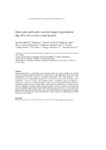Automatic multiscale vascular image segmentation algorithm for coronary angiography

Ver/Abrir
Use este enlace para citar
http://hdl.handle.net/2183/20979
Excepto si se señala otra cosa, la licencia del ítem se describe como Atribución-NoComercial-SinDerivadas 3.0 España
Colecciones
- Investigación (FIC) [1678]
Metadatos
Mostrar el registro completo del ítemTítulo
Automatic multiscale vascular image segmentation algorithm for coronary angiographyAutor(es)
Fecha
2018-09Cita bibliográfica
Carballal A, Novoa FJ, Fernández-Lozano C, García-Guimaraes M, Aldama-López G, Calviño-Santos R, et al. Automatic multiscale vascular image segmentation algorithm for coronary angiography. Biomed Signal Process Control. 2018;46:1-9
Resumen
[Abstract] Cardiovascular diseases, particularly severe stenosis, are the main cause of death in the western world. The primary method of diagnosis, considered to be the standard in the detection and quantification of stenotic lesions, is a coronary angiography. This article proposes a new automatic multiscale segmentation algorithm for the study of coronary trees that offers results comparable to the best existing semi-automatic method. According to the state-of-the-art, a representative number of coronary angiography images that ensures the generalisation capacity of the algorithm has been used. All these images were selected by clinics from an Haemodynamics Unit. An exhaustive statistical analysis was performed in terms of sensitivity, specificity and Jaccard. Algorithm improvements imply that the clinician can perform tests on the patient and, bypassing the images through the system, can verify, in that moment, the intervention of existing differences in a coronary tree from a previous test, in such a way that it could change its clinical intra-intervention criteria.
Palabras clave
Multiscale segmentation
Coronary disease
Stenotic lesions
Angiographies segmentation
Coronary disease
Stenotic lesions
Angiographies segmentation
Versión del editor
Derechos
Atribución-NoComercial-SinDerivadas 3.0 España
ISSN
1746-8094






